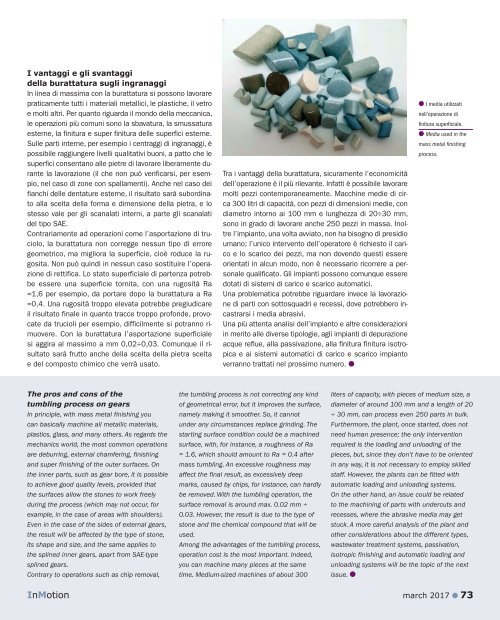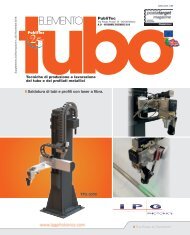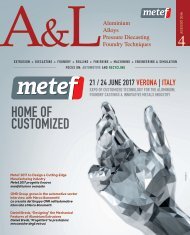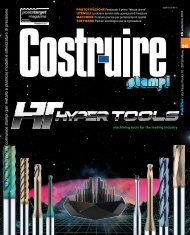PUB_INMOTION_n31_MARZO_2017_Interno96pag_160_PlanciaLR
You also want an ePaper? Increase the reach of your titles
YUMPU automatically turns print PDFs into web optimized ePapers that Google loves.
I vantaggi e gli svantaggi<br />
della burattatura sugli ingranaggi<br />
In linea di massima con la burattatura si possono lavorare<br />
praticamente tutti i materiali metallici, le plastiche, il vetro<br />
e molti altri. Per quanto riguarda il mondo della meccanica,<br />
le operazioni più comuni sono la sbavatura, la smussatura<br />
esterne, la finitura e super finitura delle superfici esterne.<br />
Sulle parti interne, per esempio i centraggi di ingranaggi, è<br />
possibile raggiungere livelli qualitativi buoni, a patto che le<br />
superfici consentano alle pietre di lavorare liberamente durante<br />
la lavorazione (il che non può verificarsi, per esempio,<br />
nel caso di zone con spallamenti). Anche nel caso dei<br />
fianchi delle dentature esterne, il risultato sarà subordinato<br />
alla scelta della forma e dimensione della pietra, e lo<br />
stesso vale per gli scanalati interni, a parte gli scanalati<br />
del tipo SAE.<br />
Contrariamente ad operazioni come l’asportazione di truciolo,<br />
la burattatura non corregge nessun tipo di errore<br />
geometrico, ma migliora la superficie, cioè roduce la rugosita.<br />
Non può quindi in nessun caso sostituire l’operazione<br />
di rettifica. Lo stato superficiale di partenza potrebbe<br />
essere una superficie tornita, con una rugosità Ra<br />
=1,6 per esempio, da portare dopo la burattatura a Ra<br />
=0,4. Una rugosità troppo elevata potrebbe pregiudicare<br />
il risultato finale in quanto tracce troppo profonde, provocate<br />
da trucioli per esempio, difficilmente si potranno rimuovere.<br />
Con la burattatura l’asportazione superficiale<br />
si aggira al massimo a mm 0,02÷0,03. Comunque il risultato<br />
sarà frutto anche della scelta della pietra scelta<br />
e del composto chimico che verrà usato.<br />
Tra i vantaggi della burattatura, sicuramente l’economicità<br />
dell’operazione è il più rilevante. Infatti è possibile lavorare<br />
molti pezzi contemporaneamente. Macchine medie di circa<br />
300 litri di capacità, con pezzi di dimensioni medie, con<br />
diametro intorno ai 100 mm e lunghezza di 20÷30 mm,<br />
sono in grado di lavorare anche 250 pezzi in massa. Inoltre<br />
l’impianto, una volta avviato, non ha bisogno di presidio<br />
umano; l’unico intervento dell’operatore è richiesto il carico<br />
e lo scarico dei pezzi, ma non dovendo questi essere<br />
orientati in alcun modo, non è necessario ricorrere a personale<br />
qualificato. Gli impianti possono comunque essere<br />
dotati di sistemi di carico e scarico automatici.<br />
Una problematica potrebbe riguardare invece la lavorazione<br />
di parti con sottosquadri e recessi, dove potrebbero incastrarsi<br />
i media abrasivi.<br />
Una più attenta analisi dell’impianto e altre considerazioni<br />
in merito alle diverse tipologie, agli impianti di depurazione<br />
acque reflue, alla passivazione, alla finitura finitura isotropica<br />
e ai sistemi automatici di carico e scarico impianto<br />
verranno trattati nel prossimo numero. l<br />
l I media utilizzati<br />
nell’operazione di<br />
finitura superficiale.<br />
l Media used in the<br />
mass metal finishing<br />
process.<br />
The pros and cons of the<br />
tumbling process on gears<br />
In principle, with mass metal finishing you<br />
can basically machine all metallic materials,<br />
plastics, glass, and many others. As regards the<br />
mechanics world, the most common operations<br />
are deburring, external chamfering, finishing<br />
and super finishing of the outer surfaces. On<br />
the inner parts, such as gear bore, it is possible<br />
to achieve good quality levels, provided that<br />
the surfaces allow the stones to work freely<br />
during the process (which may not occur, for<br />
example, in the case of areas with shoulders).<br />
Even in the case of the sides of external gears,<br />
the result will be affected by the type of stone,<br />
its shape and size, and the same applies to<br />
the splined inner gears, apart from SAE-type<br />
splined gears.<br />
Contrary to operations such as chip removal,<br />
the tumbling process is not correcting any kind<br />
of geometrical error, but it improves the surface,<br />
namely making it smoother. So, it cannot<br />
under any circumstances replace grinding. The<br />
starting surface condition could be a machined<br />
surface, with, for instance, a roughness of Ra<br />
= 1.6, which should amount to Ra = 0.4 after<br />
mass tumbling. An excessive roughness may<br />
affect the final result, as excessively deep<br />
marks, caused by chips, for instance, can hardly<br />
be removed. With the tumbling operation, the<br />
surface removal is around max. 0.02 mm ÷<br />
0.03. However, the result is due to the type of<br />
stone and the chemical compound that will be<br />
used.<br />
Among the advantages of the tumbling process,<br />
operation cost is the most important. Indeed,<br />
you can machine many pieces at the same<br />
time. Medium-sized machines of about 300<br />
liters of capacity, with pieces of medium size, a<br />
diameter of around 100 mm and a length of 20<br />
÷ 30 mm, can process even 250 parts in bulk.<br />
Furthermore, the plant, once started, does not<br />
need human presence; the only intervention<br />
required is the loading and unloading of the<br />
pieces, but, since they don’t have to be oriented<br />
in any way, it is not necessary to employ skilled<br />
staff. However, the plants can be fitted with<br />
automatic loading and unloading systems.<br />
On the other hand, an issue could be related<br />
to the machining of parts with undercuts and<br />
recesses, where the abrasive media may get<br />
stuck. A more careful analysis of the plant and<br />
other considerations about the different types,<br />
wastewater treatment systems, passivation,<br />
isotropic finishing and automatic loading and<br />
unloading systems will be the topic of the next<br />
issue. l<br />
InMotion<br />
march <strong>2017</strong> l 73





